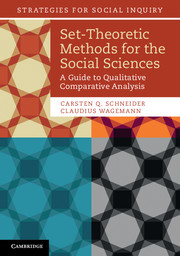Book contents
- Frontmatter
- Contents
- Figures
- Tables
- Acknowledgements
- Introduction
- Part I Set-theoretic methods: the basics
- Part II Neat formal logic meets noisy social science data
- Part III Potential pitfalls and suggestions for solutions
- Part IV Variants of QCA as a technique meet QCA as an approach
- 10 Variants of QCA
- 11 Data analysis technique meets set-theoretic approach
- 12 Looking back, looking ahead
- Glossary
- Bibliography
- Index
11 - Data analysis technique meets set-theoretic approach
Published online by Cambridge University Press: 05 November 2012
- Frontmatter
- Contents
- Figures
- Tables
- Acknowledgements
- Introduction
- Part I Set-theoretic methods: the basics
- Part II Neat formal logic meets noisy social science data
- Part III Potential pitfalls and suggestions for solutions
- Part IV Variants of QCA as a technique meet QCA as an approach
- 10 Variants of QCA
- 11 Data analysis technique meets set-theoretic approach
- 12 Looking back, looking ahead
- Glossary
- Bibliography
- Index
Summary
Recipe for a good QCA
The following recipe is a summary of what an ideal QCA should look like. We believe that providing a profile of an idea-typical QCA is fruitful, even if in research practice most published QCA comes short of fulfilling all the criteria, mostly due to restrictions in space and time. Our list can help authors, readers, and reviewers to become aware of how a given study deviates from an ideal application and to provide explicit arguments for why certain items from the list have been omitted.
The appropriateness of set-theoretic methods
The first and fundamental question to be asked is whether the use of set-theoretic methods makes sense for the research project at hand. Throughout this book, we have repeatedly argued that the use of set-theoretic methods makes sense only if a researcher has good reasons to believe (or straightforward hypotheses to be tested) that the phenomenon of interest is best understood in terms of set relations. This unavoidably implies that the researcher buys into the idea of producing causally complex accounts (section 3.3). In other words, one must find it plausible to claim that the outcome of interest is based on equifinal, conjunctural, and asymmetric relations in terms of necessary, sufficient, INUS, and/or SUIN conditions .
It seems obvious that not all – according to some, perhaps even only a minority of – research questions are adequately dealt with through set-theoretic methods . For our methodological purposes, there is no need to enter into this debate. It suffices to state that set-theoretic methods such as QCA are an adequate tool if, and only if, a researcher is interested in set relations and not correlations. Standards of good practice require that an explicit statement is made that a researcher is interested in relations between sets rather than correlations between variables.
- Type
- Chapter
- Information
- Set-Theoretic Methods for the Social SciencesA Guide to Qualitative Comparative Analysis, pp. 275 - 312Publisher: Cambridge University PressPrint publication year: 2012
- 10
- Cited by

